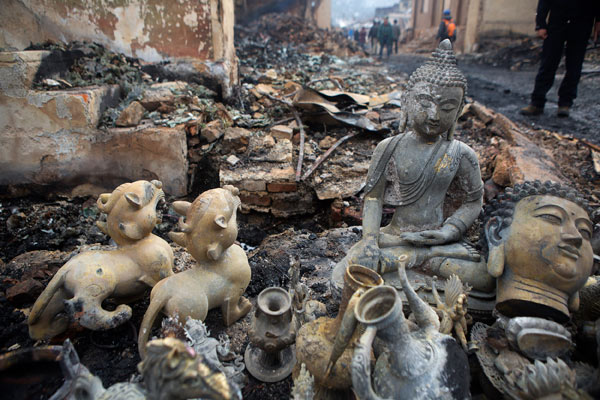Blaze prompts concern for ancient buildings
 0 Comment(s)
0 Comment(s) Print
Print E-mail China Daily, January 13, 2014
E-mail China Daily, January 13, 2014
|
|
|
Buddha statues lie among the wreckage after a fire destroyed hundreds of buildings in Dukezong, Yunnan province, on Saturday. The town is known for its well-preserved Tibetan buildings. [China Daily] |
A huge fire that engulfed an ancient Tibetan town in Shangri-la, Yunnan province, on Saturday has caused experts to call for heightened fire safety in historic locations across the country.
The fire started early on Saturday morning and lasted about 12 hours, destroying 242 houses in the old Tibetan town of Dukezong in Shangri-la, capital of the Diqing Tibet autonomous prefecture.
The blaze destroyed about a quarter of the 1,084 houses in the 1,300-year-old town and follows other fires at historic and religious sites earlier in January and November.
The Diqing firefighting bureau said on its Sina micro blog that its efforts were hampered by the need to transfer water from an elevated location, combined with the cold weather and high altitude.
The bureau said that in 2011 it invested 8 million yuan ($1.32 million) in an outdoor fire prevention system, but the combination of negative factors made their job on Saturday difficult.
They also said that the town was composed mostly of traditional wooden structures, making them extremely flammable.
Police said that they sent firefighters to the scene within five minutes of the blaze starting. Firefighters from Lijiang and Dali also assisted.
The cause of the fire is still under investigation.
Saturday's blaze was not the first conflagration in a historical Tibetan area this year. On Friday, a major fire damaged the Wuming Tibetan Buddhist Institute in Serthar, Sichuan province. The institute is one of the world's largest centers for Tibetan Buddhist learning.
In November, a fire gutted the Ganden Thubchen Choekhorling Monastery in Litang, Sichuan province. The blaze caused extensive damage to the temple's prayer hall and injured two Buddhist monks.
Also in November, the Fengyu Covered Bridge in Chongqing was turned to ashes after a fire ripped through the wooden structure. Built in 1591, the bridge boasted a pagoda-style roof and was built entirely without nails.
"The ancient buildings in Dukezong used mainly pine wood, cypress and cedar, which is dry after hundreds of years," said Lyu Zhou, a professor of ancient architecture at Tsinghua University. "The buildings are connected to each other. If one house catches fire it will easily spread to the others."
He said that fire safety should be prioritized in areas with old architecture, while fire drills should be carried out regularly in historic towns.
Lyu said that the authorities would try to restore the historic appearance of the burnt-out houses by building in the ancient style and using similar materials.
Dukezong town is the largest and best-preserved Tibetan community in all of China's Tibetan areas. It was also a key stop on the Ancient Tea-Horse Caravan Route and a focal point for Han-Tibetan exchanges.
The old town covers an area of 1.6 kilometers and is laid out in the shape of a lotus flower with eight petals, with houses radiating from Turtle Hill at its center.
Temporary shelters were set up in Dukezong on Saturday, providing food for the homeless, while more than 2,600 people are being put up in three hotels outside the old town.
Some Tibetan residents were lucky, however, as their buildings were not affected by the disaster. Among them is Aima, 29, whose hostel was not affected.
"My hostel is in the south of the old town. The fire stopped 200 meters before us," she said.
She and some other owners of hostels and restaurants are voluntarily helping those who lost homes, wishing them a quick recovery.
"We had some snow today, covering all the remains," she said. "So beautiful and quiet. It is like a rebirth."







Go to Forum >>0 Comment(s)